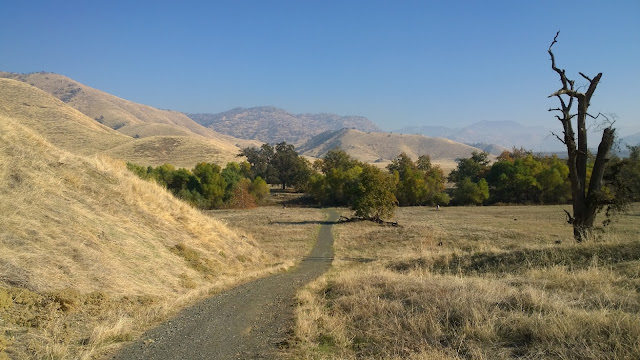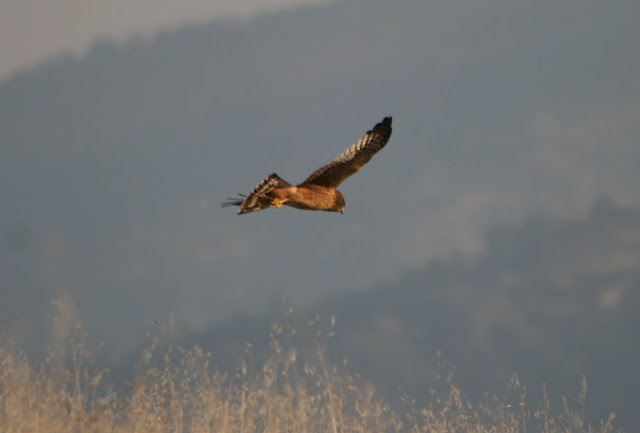Hello!
On November 30th I got out to Dry Creek Preserve, which is located in the foothills behind Woodlake. The preserve is owned and managed by Sequoia Riverland Trust (SRT) and I have been out several times over the past few years - however, dedicated birding was never my intention before. Knowing that the accessible area was mostly open land with some riparian habitat near the creek (which is currently not dry after our previous wet year), I did not go in with many expectations.
I arrived early in the afternoon and immediately set off down the hill towards the creek bed with the Canon Rebel XTi and Sigma 70-300mm lens in tow. My first shots were of a little Western Tanager that surprisingly did not auto-focus well, despite apparently doing so... I have nothing to show for that sighting! I could hear numerous little birds chattering in the trees beside the creek, which was flowing steadily but only a few inches deep. I skipped over some rocks to the other side and started up the path again. All of the nearby birds were aware of my presence and scurried off through the autumn leaves.
There were not many birds in sight but some Buckeye butterflies were hovering around. I admired a couple of them before moving on and almost went all the way up to a fork in the path before doubling back. Cattle graze on the property on a seasonal basis and I noticed a track leading down into the riparian area. I decided to give it a go and wandered in. Below is a view of a grove like what I walked through, though further up the creek.
After I got down there it did not take long before I realized it was not the best idea for birding. It felt intriguing being among the trees and I discovered some meandering streamlets, but the ground was littered with leaves that kept crunching under my feet. All of the birds stayed well apart, and at one point I even excited a Barn Owl out of a tree. However, I got no good photos and hardly any observation time... At least when I got out I could see clear skies again, and quickly caught a Red-Tail soaring overhead!
I was perhaps half way to the bottom when I noticed some Coots floating around near the far end of the pond, and also saw some very small birds flitting between the Eucalyptus branches. I did not think of it at the time, but now it seems a pity that a non-native tree has settled in so beautifully at a nature preserve... Oh, well, those thoughts were not my concern at the time! I was busy watching a cautious Coot swimming steadily out into the open water!
After I got down to the edge and became nearly stuck in the mud, I set myself up in a dry spot and a waiting game began. During the next forty five minutes I did not do much more than scan the surroundings and shift my weight from one leg to another as I crouched down or stood up at intervals. A Black Phoebe hovered around and tweeted in a lively manner but never landed nearby, and most of the Coots and what looked like a Pied-Billed Grebe kept their distance from me, whether by chance or on purpose I could not tell... In any case, I was mostly concerned with the little birds that had flown off ahead of me, but which continually moved back into my line of sight.
Heading out of the mine turned oasis, I found myself standing in an open corridor, with the creek a two or three hundred yards below the embankment and a couple of large hills on the opposite side. I looked up towards the hills and examined the silhouette of a gliding hawk, while my concentration was broken by distant croaking ravens. After fruitlessly aiming my camera at the hawk with the full 300mm, I pulled out my binoculars because something seemed peculiar. A raven was flying around with the hawk and then a Red-Tailed Hawk joined in. I was surprised to see that the Red-Tail seemed almost dwarfed by the first hawk, and I wondered if I had mistaken a Turkey Vulture.
Getting home later to fully appreciate my photos, and recalling the strange calls that I heard it making, I am now convinced that it was a Golden Eagle! This may not be a surprise for most experienced birders, as both Golden and Bald Eagles are residents in the Sierra Nevada foothills, but I was delighted. Since I began birding in earnest about fifteen months ago, this is my first sighting of an eagle in nature!
Juggling my camera, binoculars, Sibley Guide and my backpack, I finally looked away from the eagle and company to be taken by surprise. A mature female Northern Harrier was flying only a few yards from me and landed a safe distance away on the slope leading down to the pond! I crept forward but could not get close enough to do anything effective but watch it with binoculars, until it flew away to begin hunting.
I spent the next twenty minutes darting around the sloping landscape and ducking behind clumps of dry grass trying to get close to the harrier as it glided around gently. At one point it got in a bit of a fuss with the Red-Tail, which had come down from its thermal joyride. However, the two soon parted ways and the harrier resumed its patrol in a rather methodical fashion - clearly it was used to hunting in this area already.
Northern Harriers are regular migrants in the San Joaquin Valley (there is a small local population but a majority are just here seasonally). Several overwinter in the fields near my home and watching them is a passion of mine. Following this one for the opportunity to get a few decent photos was well worth the effort, and the results were my best yet!
Perhaps I would have stayed even longer but the harrier decided to move off to the east and beyond any accessible areas, so I trudged back down the hill towards the creek. It was nearly four o'clock and I had been at the Dry Creek Preserve for more than two hours. As I headed back I snapped some photos of the rather pastoral scenery around the creek and watched another Black Phoebe and a Northern Flicker fraternizing by the water. It was a very pleasant afternoon outing!













Comments
Post a Comment